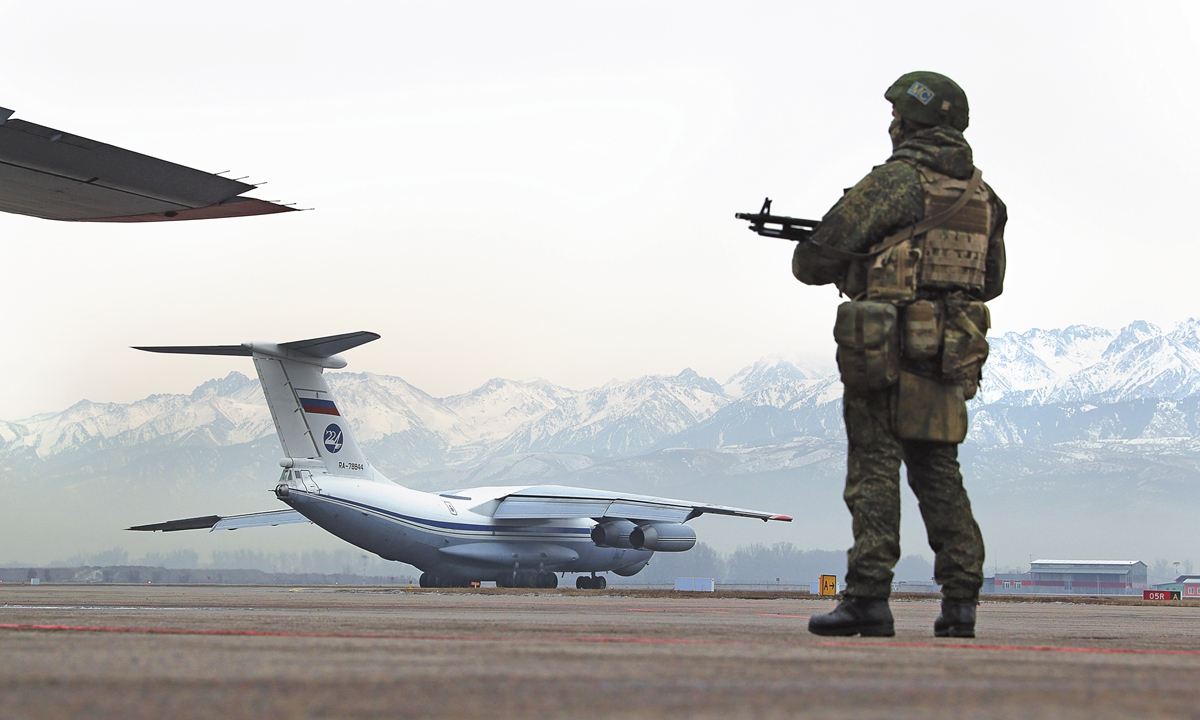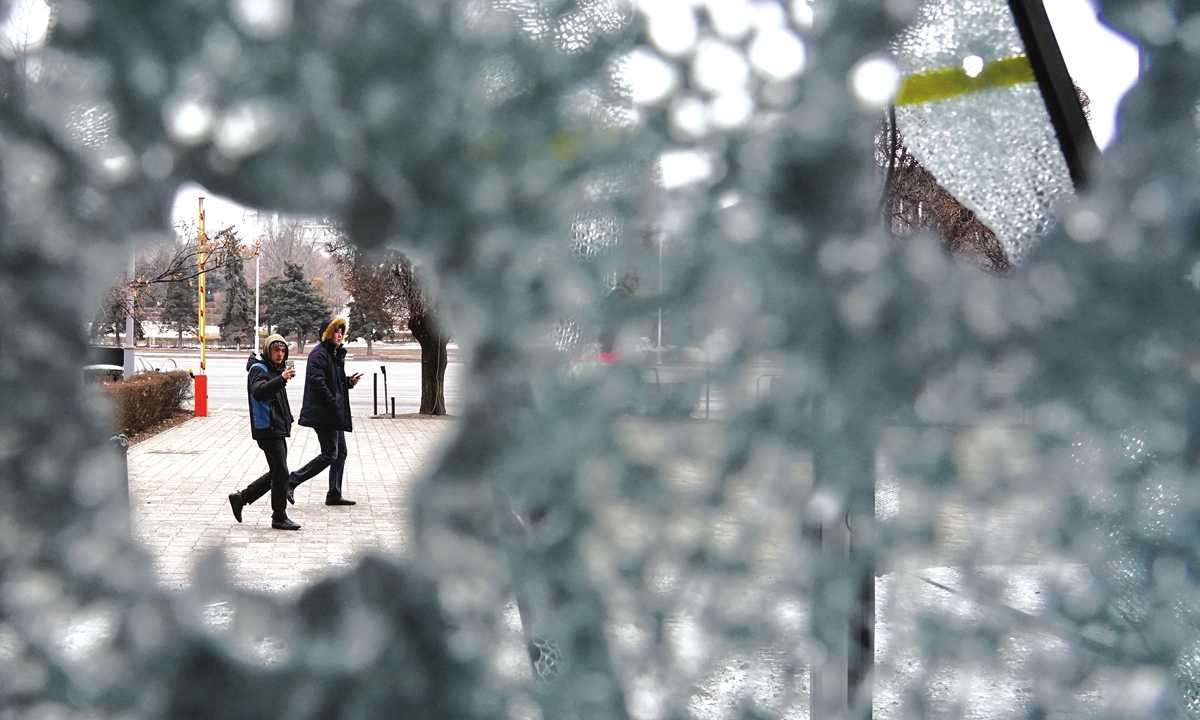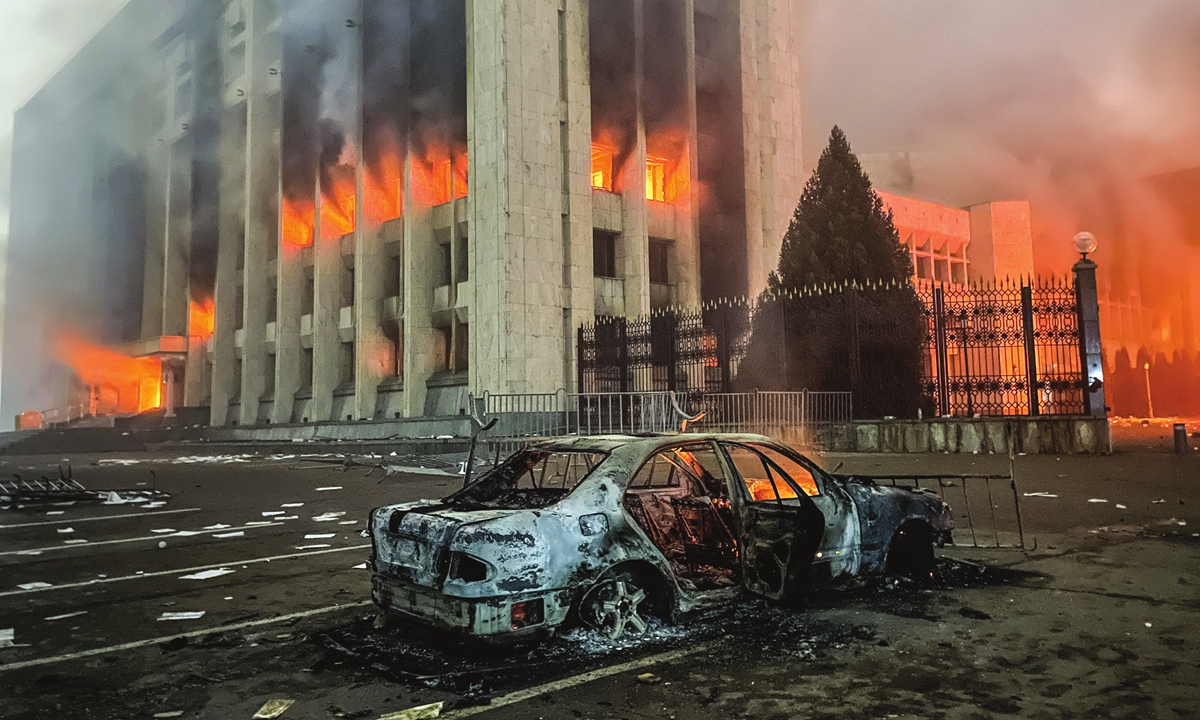‘Three Evil Forces’ continue to lurk in shadows of riots, color revolutions in Central Asia: experts
Global News 2022-02-19 22:40:124049748Malaysia United TimesNewsCenter

A homebound Ilyushin Il-76 strategic airlifter carrying Russian peacekeepers on board takes off from Almaty International Airport. Photo: VCG
Terrorism, extremism, and separatism, known as the "Three Evil Forces" have long been an unstable factor in Central Asia. Traces of these forces are once again seen in the latest regional security failure in Kazakhstan.The large-scale riots in Kazakhstan started as demonstrations, but were soon taken advantage of by extremist and terrorist groups, and were gradually turned into riots.
Kazakh authorities linked the violent protest to extremist groups, saying that preliminary data shows the attackers include individuals who have military combat zone experience in the ranks of radical Islamist groups, local media the Astana Times reported. The Kazakh government claims the number of terrorists involved in the riots is probably around 20,000.
Whether or not the "Three Evil Forces" are the main cause of the current unrest in Kazakhstan, scholars point out that they have been one of the biggest security risks in Central Asia for nearly a decade.
'Three Evil Forces' in Central Asia
"The unrest in Kazakhstan has once again revealed that some people were being paid to participate in riots on the streets, and they were likely funded by the West or the Three Evil Forces," Pan Guang, a senior expert on counterterrorism and Afghan studies at the Shanghai Academy of Social Sciences, told the Global Times.
Although the "Three Evil Forces" are not the only root of Kazakhstan's latest riots, the forces apparently took advantage of the existing instability, Zhu Yongbiao, director of the Center for Afghanistan Studies in Lanzhou University, told the Global Times.
Scholars noted that after the September 11 attacks, Central Asia became the epicenter of the "Three Evil Forces."
Pan referenced a typical case in May 2011, when thousands of workers from Kazakhstan's oil and gas sector started three separate labor strikes that then developed into clashes with security forces that resulted in mass casualties.

Street view of Almaty, Kazakhstan through a broken window after protests in the city in early January 2022 Photo: VCG
Nazarbayev's government at the time accused the strikes and protests of being instigated by anti-government forces outside the country, said Pan."We later found, in our research, that Jund al-Khilafa was behind it. The group, whose participants are mostly young men, attempted to overthrow the government of Nursultan Nazarbayev and 'establish an 'Islamic Caliphate,'" Pan said.
Terrorist activities in Kazakhstan have been at a high level since 2011, which is related to the increase in terrorist organizations around the country, Wang Yuting, an associate researcher at China Institute of Frontier Studies, Chinese Academy of Social Sciences told the Global Times.
The Kazakh government went all in to contain extremist organizations within the country, amending laws, stressing management of religion, and collaborating with international organizations, Wang explained.
According to media reports, in 2019, the Kazakh police successfully foiled three terrorist attack attempts, dismantled seven extremist groups, arrested more than 140 militants, and seized a number of guns, knives, and explosive devices. From January to July 2020, 33 terror-related crimes were committed in the country.
Kazakhstan, but the entire Central Asian region has been plagued by the activation of the "Three Evil Forces" in recent years.
Zhu pointed out that the number of attempted terrorist attacks and extremist cases in Central Asian countries solved has been increasing in recent years.
Tajikistan's police solved 1,211 terror-related crime cases in 2019, 338 more than in 2018. Police identified and arrested more than 100 members of terrorist organizations in various operations.
The security services of Kyrgyzstan and Uzbekistan have also stepped up efforts to combat terror-related crimes, arresting dozens of suspects involved in terrorist activities.
According to reports, there were about 2,000 Central Asian extremists in the IS in 2016, including about 500 from Kyrgyzstan and 300 from Kazakhstan. Many others joined the Islamic State - Khorasan Province, a branch of the IS in Central Asia. According to media reports, with the IS' setbacks in the Middle East, some jihadists have begun to secretly return to Central Asia.
Moreover, online propaganda about the "Three Evil Forces" in Central Asia has also become more common.
Since around 2015, groups like the "Jund al-Khilafa" have mostly stopped directly launching riots, but have turned to spreading "jihadist" videos on the Internet to spread cyber terrorism. At the time, a batch of video materials was also sent from Kazakhstan to China's Xinjiang Uygur Autonomous Region.
During several terrorist attacks in Xinjiang in 2014 and 2015, some jihadist videos came from Kazakhstan and Kyrgyzstan, experts noted.
Rising security risks
Ever since the collapse of the Soviet Union, five Central Asian countries have been hit hard by religious extremism, and since the rise of the Islamic State (IS), the form of terrorism in Afghanistan and in South Asia has become more severe, which also affects the security situation in Central Asia, scholars told the Global Times.
"Upheaval in Afghanistan may enable some terrorist groups to take advantage of the chaos," Pan said.
"Various terrorist cells are likely to seek new targets across the wider region," he said, naming several typical extreme religious groups that have been active in Central Asia in recent years - the "East Turkistan Islamic Movement," the Islamic Movement in Uzbekistan, the Jund al-Khilafa, the Islamic State Khorasan and the Tehrik-i-Taliban in Pakistan.
"Some extremists fled to neighboring regions pretending to be refugees," Zhu said.

A burnt car is seen by the mayor's office on fire in Almaty, Kazakhstan on January 5, 2022. Photo: VCG
While the danger continues to grow, Central Asia has not brought its capacity to respond to it to the appropriate level, a worrying fact noted by experts.In addition, the intelligence capacities and responses of countries in Central Asia are limited and may be difficult to deal with future emergencies.
Observers also point to the possibility that India and the US could further foster these forces as a geopolitical tool to contain China.
For example, India may undermine the construction of the China-Pakistan Economic Corridor by supporting and manipulating terrorist forces, while the US may directly support the "East Turkistan" forces lurking in Afghanistan, Wang said.
Analysts say that if the international community, especially the West, refuses to help Central Asia fight terrorists threat or even condones and fosters the "Three Evil Forces," there is a risk that this regional threat will spill over to other regions on a global scale.
In the future, there could be a conflagration of coups, riots, and color revolutions in the region with forces from all sides, which could be detrimental to Central Asian countries and even the international community, Zhu warned.
China's effort as example
The "Three Evil Forces" affected Xinjiang, but in recent years, situations have improved under better governance, observers noted.
There is no indication that Xinjiang has been affected by the current Kazakh unrest. Kazakhstan's Ambassador to China, Gabit Koishibayev, confirmed to the Global Times that the extreme groups that Kazakhstan has been cracking down on amid domestic unrest run no risk of spilling over to Kazakhstan's border with China, and the government thanked China for providing decisive support in guarding regional peace and security at a media conference.
In the last five or six years, China has invested heavily in anti-terrorism efforts to maintain stability and security in Xinjiang. Experts noted that some lessons that Xinjiang has learned the hard way could perhaps help Kazakhstan out of the current situation in the long run.
In managing the influence of the three forces in Xinjiang, China has put equal emphasis on source management, medium control, and protection of vulnerable groups, and has worked to eradicate the spread of religious extremist and violent terrorist ideologies at the source, cutting off the ways and channels, and eradicating the "social soil" used to grow and spread religious extremist ideologies, and has achieved success, Wang said.
Central Asian countries have a lot to do to strengthen the unity of their people. In this regard, China can play a positive role in assisting Central Asian countries counter the influence of the "Three Evil Forces."
He also noted that the group of countries should be extremely careful on the influx of extremism and terrorism through ideology and culture into China, mainly via the internet, which has happened before in Xinjiang.
The experts suggested that under the current situation, China and Central Asia can strengthen counter-terrorism cooperation through strengthened bilateral and multilateral cooperation mechanisms, and through sharing counter-terrorism intelligence information.
Pan also said that the SCO should continue to play an important role in counter-terrorism across the region in the future. SCO and CSTO are expected to further cooperate and strengthen deliberations on counter-terrorism.
Chinese State Councilor and Foreign Minister Wang Yi said that China is willing to strengthen cooperation with Kazakhstan in law enforcement and in other security sectors.
"Kazakhstan will continue to deepen and strengthen cooperation with SCO member states in various fields, especially in the field of security, and carry out more active cooperation in trade and the economy under the SCO framework," the Kazakh ambassador suggested.
Related Reading
- ‘What can we do?’: Millions in African countries need power
- JS SEZ, Forest City SFZ: Redefining the Investment Landscape, Ushering in a New Era of Commerce
- DILG: No vax exemption cards
- RCEP to take effect on first day of 2022, extend Asia-Pacific industrial chains in closer bond
- Iran stands firm
- China says to promote peace in its own way as Russia launches ‘special operation’ in Donbass
- Amazon nearing climate ‘tipping point’ faster than expected
- Environmental dilemma
- Join Our 2022 Orator & Illustrator Competition NOW!
- Tabuk mayor tests positive for COVID-19
